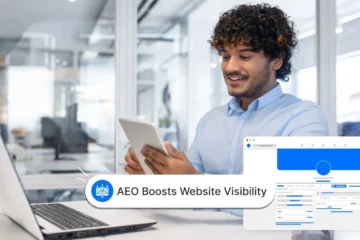The world of digital marketing is going through a major change, the biggest since search engines were introduced. AI-powered platforms are changing the way consumers find information, making marketers rethink strategies that have been popular for many years. We’re seeing a significant shift where traditional search habits are quickly evolving, creating new opportunities and challenges for businesses in every industry.
Geo Agency represents a modern approach that prioritises optimisation for AI-powered search platforms, while Traditional Marketing continues to focus mainly on conventional search engine algorithms and established digital channels. The difference between these two methods goes beyond simple tactical variations – they reflect completely different beliefs about how consumers engage with online content.
Traditional GEO marketing agency have built their knowledge around keyword rankings, backlink profiles, and Google’s algorithm updates. On the other hand, geo agencies focus on creating content that AI systems can easily understand, cite, and recommend to users looking for trustworthy information.
Generative Engine Optimisation (GEO) emerges as the bridge between these approaches. This strategy specifically targets AI platforms like ChatGPT, Perplexity, and Claude, recognising that these tools are becoming primary sources of information for millions of users. GEO focuses on semantic clarity, structured data, and authoritative content creation designed to earn citations within AI-generated responses.
The agencies adapting quickest to this shift are those combining traditional SEO foundations with GEO innovations, creating comprehensive digital strategies that remain effective across both conventional and AI-driven search environments.
What Is Driving the Shift from Traditional SEO to GEO?
AI-powered search platforms are fundamentally reshaping how consumers discover and consume information online. ChatGPT, Perplexity, and Claude have emerged as powerful alternatives to traditional search engines, offering conversational interfaces that provide direct answers rather than lists of links. Industry analysts predict this transformation will contribute to a 25-30% decline in traditional search volume by 2026, forcing marketers to reconsider their digital strategies.
Changing User Behaviour
The shift stems from changing user behaviour patterns. Consumers increasingly trust AI-generated responses for their accuracy and comprehensiveness. Research indicates that 68% of users prefer AI-generated summaries over traditional search results when seeking quick answers to complex queries. This preference creates a new landscape where visibility depends on being cited within AI responses rather than ranking highly on search engine results pages.
Introducing Generative Engine Optimisation (GEO)
Generative Engine Optimisation addresses this evolution by focusing on how AI systems interpret, process, and cite content. Unlike traditional SEO that targets keyword rankings, GEO optimises for:
- Citation frequency in AI-generated responses
- Authority signals that AI platforms recognise
- Semantic clarity that enhances AI comprehension
- Structured data that facilitates AI parsing
Adapting to the Technical Architecture of AI Platforms
The technical architecture of AI platforms differs significantly from traditional search algorithms. These systems evaluate content based on credibility markers, factual accuracy, and contextual relevance rather than traditional ranking factors like backlinks or keyword density. This fundamental difference requires marketers to adapt their content creation and optimisation strategies to align with how AI systems assess and present information to users.
How Does GEO Differ from Traditional Marketing Approaches?
The shift from traditional SEO to GEO represents a complete reimagining of how content reaches audiences. Traditional marketing approaches centre around keyword rankings and search result positioning, whilst GEO prioritises direct citation within AI-generated responses. When ChatGPT or Perplexity answers a user query, your content becomes part of the response itself rather than a link destination.
Content Synthesis: The Cornerstone of GEO Strategy
AI platforms don’t simply index your content—they analyse, understand, and incorporate your information into comprehensive answers. This requires a shift from keyword-stuffed content to information that AI systems can easily parse and reference as outlined in this comprehensive AI SEO guide.
The Technical Foundations of GEO
The technical foundations differ dramatically between traditional SEO and GEO:
- Semantic optimization replaces traditional keyword density metrics
- Entity recognition helps AI platforms understand your content’s context and authority
- AI citations become more valuable than backlink profiles
- Structured data markup transforms from optional to essential
Thinking Beyond Individual Web Pages
You need to think beyond individual web pages. Multi-platform distribution ensures your content appears across various AI training datasets and knowledge bases. This means publishing on platforms where AI systems actively crawl and learn from content, which is increasingly becoming a crucial aspect of SEO and digital marketing.
Semantic Clarity as Your Competitive Advantage
Semantic clarity becomes your competitive advantage. AI platforms favour content that clearly defines concepts, provides specific data points, and maintains consistent terminology. Your content must answer questions directly rather than dancing around topics with marketing fluff.
Signalling Authority to AI Systems
Credible citations within your content signal authority to AI systems. When you reference authoritative sources, studies, and data, AI platforms recognise your content as trustworthy and worth citing in their responses. This aligns with the principles of Google’s E-E-A-T framework, which emphasises the importance of expertise, authoritativeness, and trustworthiness in online content.
What Are the Key Components of an Effective GEO Strategy?
Building a successful GEO strategy requires four foundational pillars that work together to maximise your visibility across AI-driven search platforms. Each component plays a distinct role in helping generative engines understand, trust, and cite your content.
1. Content Structure
Content Structure forms the backbone of effective GEO implementation. You need to establish clear hierarchical organisation using proper heading tags (H1, H2, H3) that create logical information pathways. AI crawlers interpret this structure to understand your content’s context and relevance. When agencies like Covert develop content strategies for their clients, they prioritise this hierarchical approach to ensure AI platforms can easily parse and reference their information.
2. Credible Sources
Credible Sources serve as your authority foundation. You must incorporate citations from recognised industry publications, academic research, and established thought leaders within your content. These references signal trustworthiness to AI systems, increasing the likelihood of direct citations in generated responses. The quality and relevance of your source material directly impacts your content’s perceived authority.
3. Technical Optimisation
Technical Optimisation encompasses the performance elements that AI crawlers evaluate. Your site must deliver fast loading speeds, seamless mobile experiences, and clean code architecture. These technical essentials ensure AI systems can efficiently access and process your content without encountering barriers that might limit indexing or comprehension.
4. Schema Markup
Schema Markup acts as your communication bridge with AI crawlers. Structured data helps these systems understand your content’s meaning, context, and relationships. Implementing comprehensive schema markup enables AI platforms to extract precise information from your pages, improving your chances of appearing in AI-generated responses with accurate attribution.
How Can Agencies Integrate GEO with Traditional SEO for Maximum Impact?
Smart agencies recognise that GEO and traditional SEO work best as complementary strategies rather than competing approaches. You can create a unified digital strategy that captures both traditional search traffic and AI-generated recommendations by building comprehensive topic clusters that serve multiple search ecosystems simultaneously.
The foundation lies in developing content that demonstrates genuine industry expertise across interconnected subjects. When Covert works with clients like Roses Only, they create content hierarchies that address both keyword-focused queries and the nuanced questions AI platforms prioritise. This dual approach ensures your content appears in traditional SERPs whilst also being cited by generative AI responses.
Technical implementation becomes crucial when merging these strategies:
- Schema markup that satisfies both Google’s crawlers and AI comprehension requirements
- Internal linking structures that reinforce topic authority for traditional SEO whilst providing clear context paths for AI systems
- Content depth that answers immediate queries (traditional SEO) and provides comprehensive context (GEO)
Your domain authority benefits when you publish content that serves as both a ranking signal for search engines and a credible source for AI citations. This means creating resources that other industry experts reference, establishing your site as a hub of authoritative information.
The key lies in understanding that traditional SEO metrics like keyword rankings complement GEO metrics such as citation frequency in AI responses. You’re not replacing one strategy with another; you’re expanding your digital footprint across multiple search environments. This integrated approach positions your agency’s clients to capture traffic regardless of how search behaviour evolves, ensuring sustained visibility as AI platforms gain prominence alongside traditional search engines.

What Are The Implications Of GEO On E-commerce And B2B Marketing?
E-commerce digital marketing is undergoing a significant change as GEO reshapes how customers discover and assess products. With the introduction of visual search capabilities in AI platforms, new opportunities for product discovery have emerged. Customers can now upload images and receive personalised product recommendations along with direct links for purchasing. It’s important to note that AI-generated responses are increasingly favouring retailers who offer detailed product specifications, genuine customer reviews, and well-structured pricing information that generative engines can easily understand and present.
The traditional funnel approach becomes less relevant when AI platforms deliver instant, contextualised product comparisons. Your e-commerce strategy must now prioritise:
- Rich product descriptions with technical specifications that AI can extract and cite
- Customer review integration across multiple platforms for credibility signals
- Visual content optimisation for multimodal AI interpretation
- Schema markup for product availability, pricing, and shipping information
B2B companies face different challenges as GEO places importance on clearly demonstrating expertise through authoritative content. When generating responses about complex business solutions, AI platforms heavily consider industry credentials, case studies, and thought leadership. This means that your B2B content strategy needs to include more in-depth technical documentation, white papers, and industry-specific terminology in order to establish your organisation as a credible source.
Professional services firms like SEO Henderson Advocacy are benefiting from GEO’s preference for showcasing detailed expertise. For instance, when potential clients inquire about buyer agency strategies on AI platforms, comprehensive case studies and explanations of methodologies are more likely to be cited. As a result, B2B marketers must adapt their content creation efforts to cater to both human decision-makers and AI systems seeking reliable business intelligence.
How Do Multimodal AI Interfaces Influence Digital Marketing Strategies?
Multimodal AI platforms are reshaping how you approach digital marketing by accepting diverse input formats beyond traditional text queries. Users now interact with AI systems through images, videos, audio recordings, and voice commands, creating new touchpoints for your brand visibility.
Visual Search Revolution
Image-based queries demand that your visual content becomes discoverable through AI recognition systems. Product photography, infographics, and branded visuals require optimisation for AI comprehension through:
- Alt text optimisation with descriptive, keyword-rich descriptions
- Image schema markup to provide context for AI crawlers
- High-quality visual assets that AI systems can accurately interpret
Voice Assistants Transform Customer Interactions
Voice technology integration across sectors creates opportunities for conversational marketing strategies. Your content must adapt to natural language patterns that users employ when speaking rather than typing. This shift affects:
- Content structure favouring question-and-answer formats
- Local SEO emphasis as voice searches often include location-based queries
- Featured snippet optimisation since voice assistants frequently read these responses
Audio Content Opportunities
Podcast transcriptions, audio descriptions, and voice-over content become searchable assets when properly structured. AI systems analyse audio content for relevant information, making your spoken content a valuable SEO resource.
The difference between Geo Agency vs. Traditional Marketing: What’s Changing in Digital Strategy is clear as agencies must now optimise across multiple content formats simultaneously. Traditional keyword-focused approaches expand to include visual recognition, voice pattern analysis, and audio content indexing, requiring comprehensive multimodal strategies that address each interface type effectively.
What Challenges Do Marketers Face When Transitioning To GEO?
The move from traditional SEO to GEO comes with its own set of challenges that need careful handling.
1. Over-optimization risks
One of the main worries is the danger of over-optimising when agencies concentrate only on one AI platform. You might end up creating content specifically for ChatGPT while ignoring Perplexity or Claude, resulting in a limited optimisation strategy that restricts your reach across the generative AI landscape.
2. Single-platform dependency
Relying solely on one platform makes your digital strategy vulnerable. If you focus all your efforts on optimising for a single AI engine, any changes in algorithms or platforms can have a severe impact on your visibility. This challenge is similar to the risks associated with depending on Google in the past, but it becomes even more significant when multiple AI platforms with different requirements and preferences are involved.
3. Technical implementation hurdles
Another major obstacle is the technical difficulties in implementing changes. When AI crawlers struggle to understand dynamic content, issues with JavaScript rendering become particularly problematic. Your website may appear perfectly fine to human users but remain invisible to AI systems that cannot process complex JavaScript frameworks. To bridge this technical gap, you need to find a balance between modern web development practices and the accessibility needs of AI.
4. Content restructuring demands
Transforming existing content structures to align with how AI understands things while still providing a good user experience requires significant resources. This shift calls for expertise in implementing structured data, using semantic markup, and formatting citations—skills that traditional marketing teams may not possess.
5. Measurement complexity
Adding another layer of difficulty is the complexity involved in measuring success. Traditional metrics like keyword rankings become less important when success relies on how often citations appear in AI responses. You will need to come up with new ways of tracking performance across various generative platforms, which means investing in specialised tools and analytics frameworks that many agencies have not yet adopted.
Moreover, as we embrace these new frameworks, it’s crucial to understand their impact on SEO effectiveness. A discussion on Reddit highlights some insights into this aspect, suggesting that adapting our strategies to incorporate these new frameworks could yield better results if approached thoughtfully.
How Is Success Measured Differently In A GEO-Focused Strategy?
The metrics that define success in traditional SEO become inadequate when evaluating GEO performance. You need to shift your measurement framework to capture how AI platforms interact with and present your content.
1. Citation Tracking: The Primary Success Indicator
Unlike traditional keyword rankings, you must monitor how frequently AI platforms like ChatGPT, Perplexity, and Claude reference your content directly. This involves tracking when your brand, research, or expertise appears in AI-generated responses across different queries and platforms.
Key GEO Metrics to Monitor:
- Direct citation frequency – How often AI platforms quote or reference your content
- Source attribution quality – Whether citations include proper links and context
- Response positioning – Where your content appears within AI-generated answers
- Query coverage – The breadth of topics where your content gets cited
2. Referral Analytics: Identifying Traffic from AI Platforms
Referral analytics require sophisticated tracking systems that can identify traffic originating from AI platforms. You’ll need to implement UTM parameters and custom tracking codes to capture these unique traffic sources, as traditional analytics tools often struggle to categorise AI-driven referrals accurately.
3. Brand Mentions in AI Responses: Understanding Your Authority Positioning
Brand mentions in AI responses provide qualitative insights into your authority positioning. You should analyse the context surrounding these mentions – whether your brand appears as a primary source, supporting reference, or expert opinion. This qualitative assessment helps gauge your content’s perceived credibility within AI ecosystems.

4. Real-Time Monitoring Tools for Effective Measurement
The measurement approach demands real-time monitoring tools specifically designed for AI platform tracking. Traditional SEO tools like SEMrush or Ahrefs lack the capability to monitor AI citation patterns effectively, requiring you to invest in specialised GEO analytics platforms or develop custom monitoring solutions.
Conclusion
The future of digital marketing requires agencies to completely rethink how they achieve visibility and engagement. GEO is more than just another optimisation technique; it represents a major shift towards AI-first content strategies that prioritise clear meaning and authoritative positioning.
You must adopt multi-channel presence strategies that go beyond traditional search engines. The most successful agencies will be those that seamlessly combine technical optimisation with authoritative content creation, ensuring their clients remain relevant across both conventional search platforms and emerging AI-driven interfaces.
The shift from traditional keyword-focused methods to citation-driven visibility needs new ways of measuring success. You can no longer depend solely on rankings and click-through rates. Success metrics must evolve to include AI platform citations, semantic authority scores, and cross-platform content performance.
Geo Agency vs. Traditional Marketing: What’s Changing in Digital Strategy isn’t simply about choosing one approach over another. The winning strategy combines the proven foundations of traditional SEO with the forward-thinking principles of GEO. Agencies like Covert and specialists in e-commerce digital marketing are already showing how this combined approach delivers better results.
Your agency’s competitive advantage lies in mastering both worlds—maintaining domain authority through established SEO practices while also optimising for the AI-driven search landscape that’s quickly becoming the new standard for finding information.
More to Read : ChatGPT AEO Agency: Strategies to Be the Answer in AI Responses


0 Comments